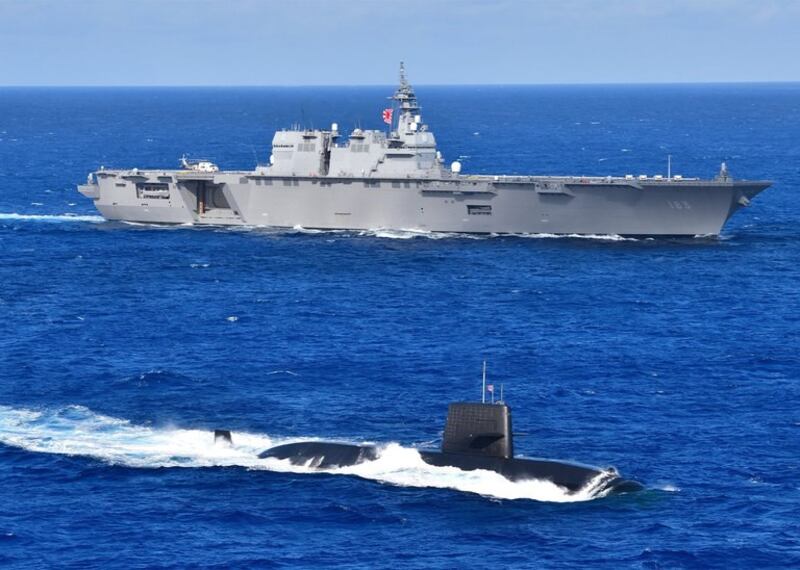A combined naval exercise led by Japan wrapped up in the South China Sea in a display of allied solidarity amid increased regional tensions.
The week-long exercise involving maritime forces from Canada, Japan, and the United States ended Sunday. It was held off the back of another trilateral exercise, Noble Raven 22, which concluded in the Western Pacific a month earlier.
The drills, dubbed Noble Raven 22-2, saw the rare appearance of a Japanese submarine that may signal a future deployment of Japan’s subs in the region.
This is only the second time a Japanese submarine took part in joint drills in the South China Sea. The first was in November 2021, in a bilateral exercise with the U.S. Navy.
China's growing assertiveness against other claimant states in the South China Sea, and Japan in the East China Sea presents a "grave concern for Japan," according to a report by the ISEAS-Yusof Ishak Institute in Singapore.
"We will continue to strengthen cooperation with allied and partner navies, contribute to peace and stability in the region and maintain maritime order to realize a Free and Open Indo-Pacific," said the Japanese Navy, known officially as the Japan Maritime Self-Defense Force (JMSDF) since Japan's post-war constitution prohibits its military from fighting abroad.
Besides the submarine, Japan sent one of its two destroyers, the JS Izumo, and the JS Takanami.
The U.S. sent the Arleigh Burke-class guided-missile destroyer USS Higgins and fleet replenishment-oiler USNS Rappahannock. For its part, the Royal Canadian Navy sent two frigates, HMCS Winnipeg and HMCS Vancouver.
The two Canadian frigates have been deployed to Operation NEON to monitor United Nations Security Council sanctions against North Korea’s weapons of mass destruction programs.
The Vancouver took part in the original Noble Raven 22 from Aug. 30 to Sept. 7 in the waters running from Guam to the South China Sea. It also conducted a transit through the Taiwan Strait on Sept. 20 alongside the U.S. Navy destroyer USS Higgins.

Japan’s Indo-Pacific Deployment
The Izumo and Takanami are part of the JMSDF’s Indo-Pacific Deployment 2022 (IPD22), a four-month deployment in the Indo-Pacific region from June 13 to Oct. 28.
During Noble Raven 22-2, the three participating navies conducted "maritime operations, anti-submarine warfare operations, air warfare operations, live-fire missile events, and advanced maneuvering scenarios," according to a press release from the U.S. Navy's 7th Fleet.
Cmdr. Joseph McGettigan, commanding officer of the USS Higgins, was quoted as saying that the “seamless interoperability between all ships demonstrates the strength of our alliances.”
It has been a busy time for the Japanese military. The JMSDF, together with the U.S. Navy and the Republic of Korea (ROK) Navy, conducted a trilateral anti-submarine warfare exercise in the waters near Korea and Japan on Sept. 30.
The U.S. Navy's only forward-deployed aircraft carrier, USS Ronald Reagan, and its strike group joined Japanese and Korean destroyers in high intensity exercises to "enhance our combined capabilities against enemy submarine threats," according to another statement from the 7th Fleet.
In late August, maritime forces from the U.S., Japan, Republic of Korea, Australia and Canada sailed together in the week-long Exercise Pacific Vanguard 2022 in the seas off Guam.
In the latest development, following North Korea’s ballistic missile launch over Japan on Oct. 4, the Japan Air Self-Defense Force (JASDF), or the Japanese Air Force, held a bilateral exercise with U.S. Marine Corps fighters over the Sea of Japan on the same day.
China has yet to say anything about the trilateral exercise in the South China Sea or the large-scale annual military drills, Kamandag, between the U.S. and the Philippines that began on Monday.
Experts say the South China Sea is playing an important part in Japan’s maritime strategy where Tokyo is taking a multilateral approach to pushing back on Chinese territorial claims.
Reported by Radio Free Asia, an online news affiliate of BenarNews.

